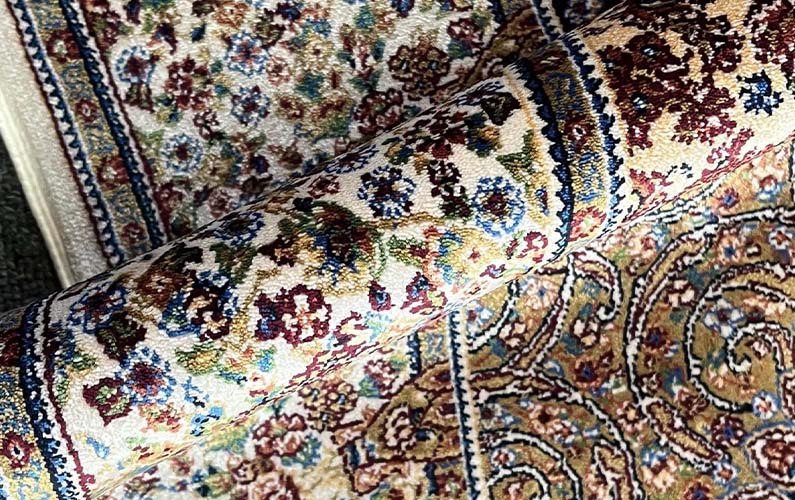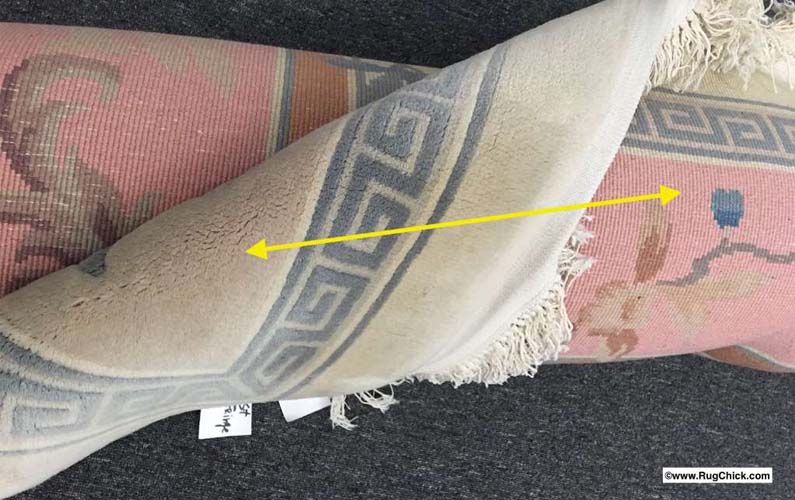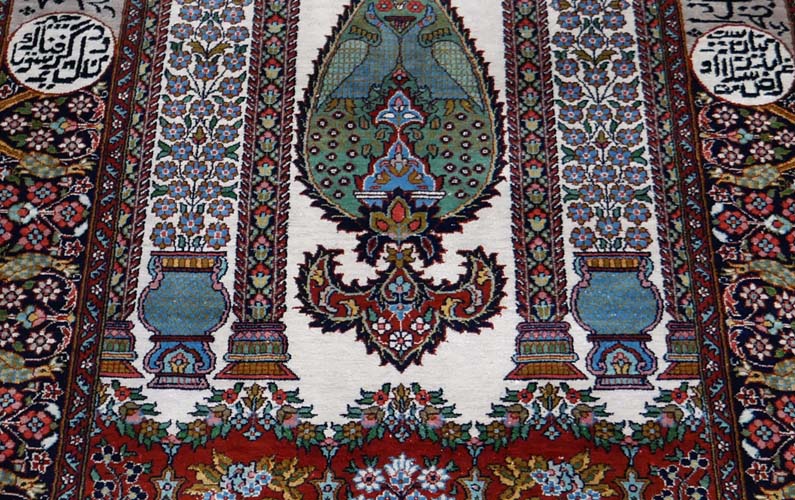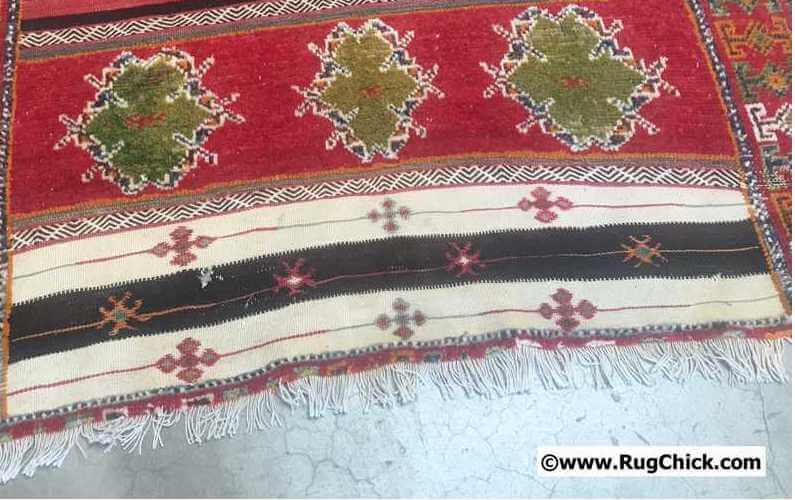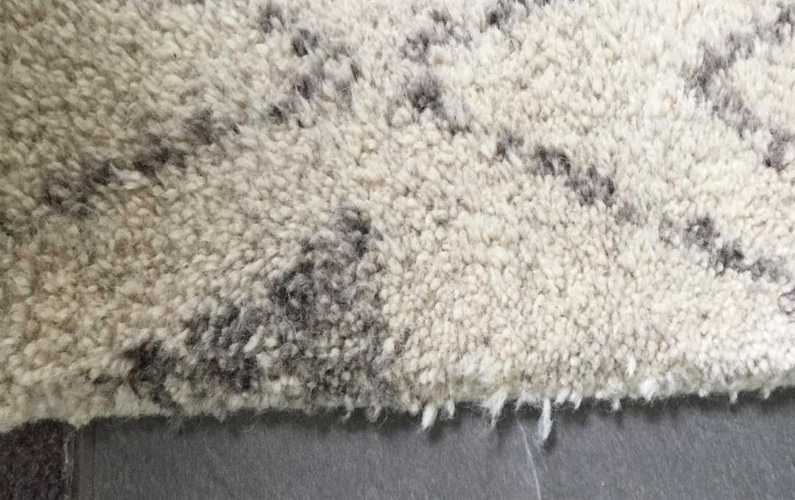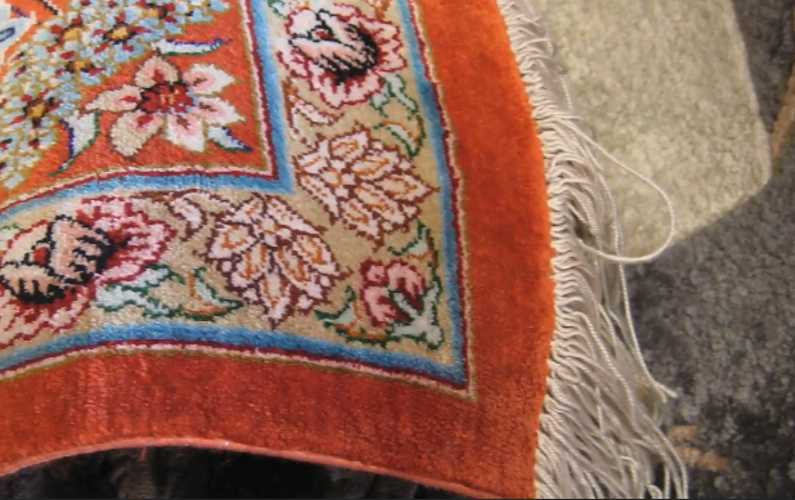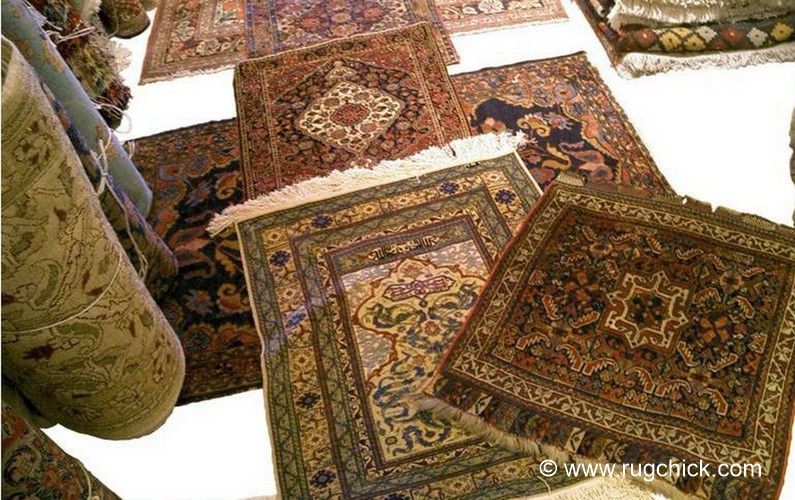Rug White Knots (What You Need To Know)
“My rug has white dots in the field, is this damage?”
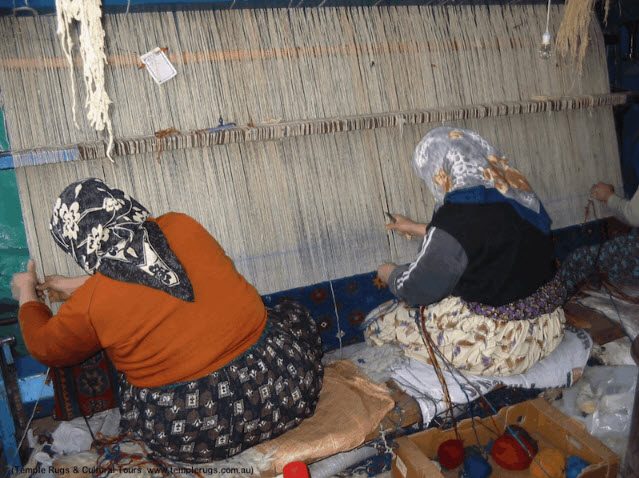
Three Turkish weavers at their rug loom.(Courtesy of Tempe Rugs & Cultural Tours www.TempleRugs.com.au.)
Many rug cleaners, and rug owners for that matter, do not know that the “100% WOOL RUG” in front of them (that is what the label says) often has a very large amount of COTTON in it.
In the loom photo to the right, Turkish weavers are weaving a wool rug. You can see very clearly that cotton has been strung up on the loom as the warps (fibers running the LENGTH of the rug) and that cotton is also being used as the wefts (fibers running the WIDTH of the rug in between the rows of knots to hold them in place).
If the hand woven rug you are looking at has white cotton fringe, those tassels are the warps that run from that end all the way through to the opposite side. It is literally what the wool pile strands are twisted around to create that rug’s pile.
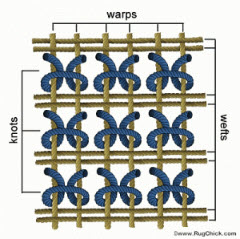
Rug weaving structure diagram. Warps run vertically and are the fringe tassels. Wefts run horizontally (“weft” to “wight”). The wool knots are twisted around the warps and packed into place by the wefts.
Weavers, especially of larger size rugs, do not have an endless spool of cotton thread to use. They are limited lengths. So when the strand is done, they are tied to another strand so that they can continue to wrap the warps around the loom bars.
This is similarly done with the weft strands that run the width of the rug in between the rows of wool knots.
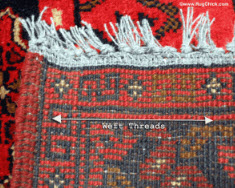
Wefts are run in front and behind each warp strand, from left to right (or right to left) to help hold the wool knots firmly in place. In this rug the wefts are brown and the warps are grey.
Sometimes the warps or wefts, as a result of the constant packing of the knots into place with often metal weaving tools, can break during the weaving process. When this happens, two ends are tied together so that the weaving can continue.
This means that there are quite a number of FOUNDATION FIBER KNOTS in every single hand woven rug.
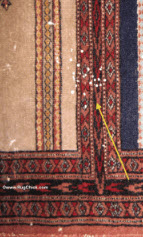
I refer to white knots as “rug freckles.” Every hand woven rug has them. Some only a few. Some many more.
There are either a small number of them, or a large number of them, depending on the availability of long, strong cotton strands, and depending on the weaver doing the work’s skill level and how often they break strands.
I call these foundation knots “RUG FRECKLES“, and just as with real freckles, everyone has them. Either just a few, or more than a few.
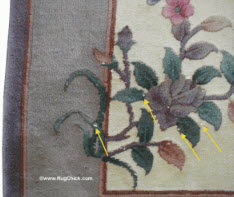
A few white cotton foundation strands peek through on this Chinese rug.
WHAT WHITE KNOTS ARE
Rug white knots are foundation fiber tie off points. These are either warps, or wefts. They are a by-product of the weaving process.
It is just not possible to tie tens of thousands (sometimes hundreds of thousands) of knots to create a rug and not have the foundation strands not break now and then.
These “rug freckles” exist in every hand woven rug. The majority of the freckles will be white, but you do sometimes see other colors if the cotton is dyed (sometimes wefts are a variety of colors) or if wool is being used as the warps or wefts (sometimes in tribal rugs) then you may see brown or gray knots.
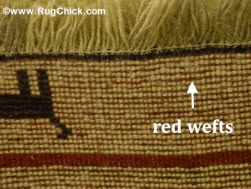
Back view of a Gabbeh rug with RED weft threads.
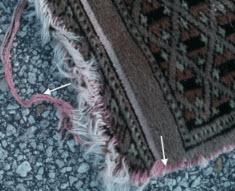
Pakistan rug is unraveling along the end and side which is exposing its PINK weft threads. This means this rug may have white knots (from the white warp threads that are the tassels of this rug) OR pink knots (from the weft threads that may have broken and been tied during the weaving process).
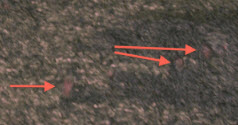
Instead of “white” knots, this rug has “pink” knots.
Weavers will do one of three things with these “RUG FRECKLES”: 1) they will either push the knot toward the back side of the rug with a needle to help make it less noticeable; 2) clip down the loose strands to make the knots shorter than the wool pile (so they are hidden); or 3) blend them away with dye after the weaving is completed (RUG MAKE-UP!!!).
HOW WHITE KNOTS BECOME MORE VISIBLE
There are two ways that white knots become more visible – age and a really good washing.
With age what happens is that the wool pile begins to wear from foot traffic, and the white knots that used to be shorter than the wool pile, begin to be revealed. (By the way, one of the primary reasons to have a pad under hand woven rugs is to help dramatically lessen the friction from foot traffic.)
With newer rugs that are sheared with a very low nap (which is quite fashionable with today’s rugs), this can make the white knots more visible in even a relatively new rug. In fact, this is one of the more common reasons we are asked out into the field to inspect new rugs for “damage” – they see white knots popping up in their “new” rug. Normally these would be hidden by the longer wool pile, but the very short shearing has made that more difficult to do.
With washing what happens is that soiled rugs make the white cotton knots grey and not very noticeable. A really good bath will make these cotton knots pristine white again (especially if you have a skilled rug specialist doing the work), and they suddenly “appear” when before you may not have seen them.

White knots visible in the field of this hand woven rug after a really good bath.
Because every hand woven rug has these foundation knot “freckles,” it is important as a rug cleaner to point them out BEFORE the wash rather than after.
When it is done before the wash it is educating the rug owner about the characteristics of their rug, and when it is done after the wash it is sometimes seen as an excuse.
When a rug is dirty you may not easily find the “white knots” because they are not white, they are gray from soil. But you will be able to find them on the BACK SIDE of the rug. When you see larger white knot areas on the back side, you should be able to find the matching knot on the opposite front side.
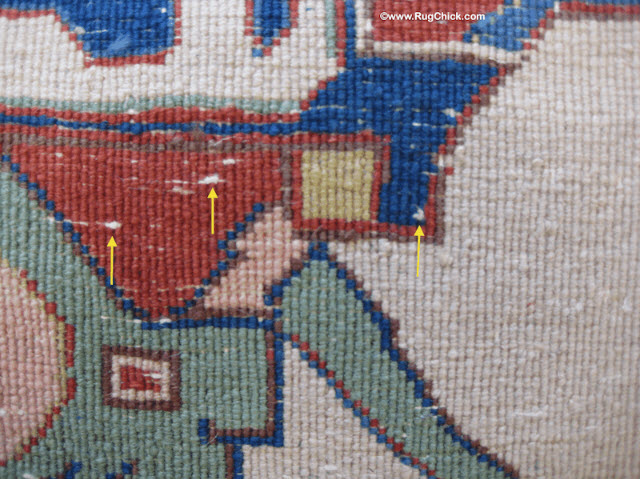
White knots are visible on the back side of this rug.
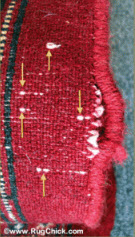
The back side of a Pakistan Bokhara rug, you can see the side cord pulling away (a common problem with this type of rug) but you also can see several white knots visible from the back that the wool pile on the front side is completely hiding. They will not be more visible on the front until the rug is older with a little more wear.
WHAT CAN BE DONE WITH WHITE KNOTS
There are four possible choices when dealing with “rug freckles.”
The first is to just leave them alone. A number of rug owners do not mind a few freckles in their rugs.
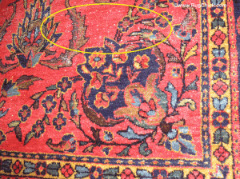
White knots and a little bit of field wear on this Sarouk rug may be left alone because it is expected in a rug of this age, and is not very noticeable at all.
The second is to, if the weave of the rug is loose enough, to push the knots more toward the back side of the rug so they are less visible. You have to be careful though, because if these knots untie, you can create a hole in the rug that may not be correctable.
The third is to clip the strands of the knot lower than the wool pile if they are more “white strands” instead of “white knots.” Again, you want to take care to not create a hole you cannot fix.
The fourth is to dye away the knots with textile dye or ink. This is purely cosmetic, but it holds no risk to the structure of the rug in terms of potentially creating a hole. This is the most common choice for tackling a small number of rug freckles.

Age and foot wear have exposed a large number of white knots on this Persian rug. Trying to dye this many “freckles” may not be possible, attractive, or affordable. It may be a better choice to rotate the rug so that this more worn area is under furniture instead.
WHITE KNOT WRAP-UP
White knots are present in every hand woven rug. They are a characteristic of the weaving process and are not rug damage.
After washing these “freckles” may become more noticeable because they are no longer covered up with soil. They also pop up more in areas where there is more wearing down of the wool pile due to foot traffic and age.
The goal as a rug cleaner is to find the white knots BEFORE the cleaning, and to offer repair options at that time so that there are no surprises after the wash reveals them to their owner again.
Happy Rug Cleaning!
Lisa
P.S. Those of you who are professional rug cleaners, if you are interested in on-line, or in-person rug care training, visit my training page for more details on my upcoming calendar.

